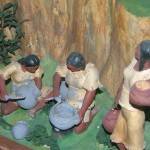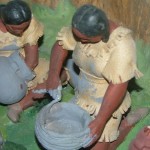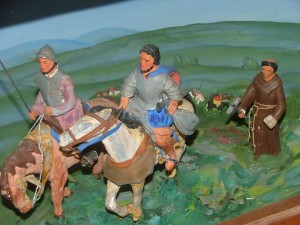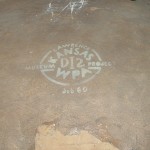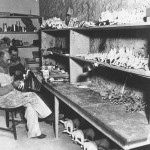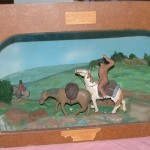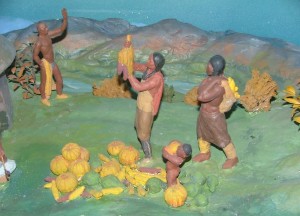by Kristine Schmucker, HCHM Curator
Years ago, students at Washington Elementary School walked past these stories without words; five dioramas depicting various scenes from the history of Kansas. In one scene, three Native American women are shaping earthen pots and bowls.
- WPA Indian Diorama No. 4, Pawnee Pottery Making, ca. 1939-1941.
- Detail of Indian Diorama No. 4..
In another, Coronado marches across the Kansas prairie.
The dioramas were purchased by Washington Elementary School, Newton, in the early 1940s and used in classrooms for a number of years. Eventually, the dioramas were put into storage at the school. In 1986, they were rediscovered by local art teacher, Phil Epp. He took them to his class room at Santa Fe Middle School to use in his classes. When the Santa Fe Middle school was renovated in 2000, the dioramas were again put into storage. Three years later, a case was constructed to exhibit the dioramas in the school. Again, over time, their importance became lost and they returned to storage. In the fall of 2014, the WPA Diorama Series was donated to the Harvey County Historical Museum & Archives, Newton, Ks.
Most are probably familiar with the WPA Project, the federal work-relief program that hired the unemployed to build bridges, roads, and public buildings and parks during the late 1930s. Less familiar is the program within the WPA that created these dioramas – the Museum Project. There were twenty-four states that had programs to create these “most effective of visual aids.” However, in only four states, including Kansas, did the program, “develop into a dynamic state-wide organization offering a variety of art objects, artifacts and printed titles.” The Museum Progect hired unemployed artists, photographers, cabinetmakers and teachers to worked along side the ‘regular’ staff in museums. An additional purpose was to “help public schools to obtain visual education aids designed to give life and reality to the things children study.”
In Kansas, the Museum Project created several groups of dioramas depicting the life of early Indian tribes, and episodes from Kansas history. Tax- supported educational institutions could order the dioramas they wanted from the Visual Aids Catalogue and Year Book.
There were three workshops where the artists created the dioramas. The Newton set was made in Lawrence, Ks between 1939-1941.
- Workshop in Lawrence. Photo courtesy Kansas Memory at http://www.kansasmemory.org/item/14893
- WPA Logo on the back of the diorama. In 1940 or 1941, the Newton Public Schools purchased five dioramas which were made in the Lawrence, Kansas workshop between 1939 and 1941. By the 1980s, Newton’s dioramas were forgotten after being put into storage at Washington Elementary School. In 1986, the dioramas were uncovered by local art teacher Phil Epp. He put them into use in his classroom at Santa Fe Middle School in Newton. They were used until a 2000 renovation of the school, put into storage for several years, returned to classroom use, placed back into storage, and then donated in 2014 to the Harvey County Historical Museum.
- Painting diorama figures. There were three workshops where artists created the dioramas. The scenes depicted were Pawnee pottery making, Coronado’s March, Four Horses Trading Post (also known as the Choteau Brothers Trading Fort), and a Kansa Harvest. Each diorama came with labels giving information about the scene being portrayed. Photo courtesy Kansas Memory at http://kansasmemory.org/item/14898
The dioramas often depicted real places and actual historical events. Kansas History Diorama No. 2, Four Horses Trading Post, also known as the Choteau Brothers Trading Fort, shows one of the earliest trading posts in Kansas. The trading post was established in 1820-21 by two brothers Francis and Cyprian about twenty miles above the mouth of the Kansas River near present day Bonner Springs, Kansas.
- Kansas History Diorama No. 2, Four Horses Trading Post, ca. 1939-1941.
- WPA Dioramas, 1939-1941. During the late 1930s, federal Work Projects Administration (WPA) launched numerous federal work-relief programs. One of these was the Kansas Museum Project. It created dioramas for use in public schools. Their purpose was educational; and the scenes were intended to be a realistic depiction of an aspect of Kansas history. Portrayed were episodes from Kansas history and the life of early Indian tribes. Side view of Kansas History Diorama No. 2, Four Horses Trading Post
The text provided along with the diorama describes the scene:
“a beaver trapper and his Indian wife approaching the Four Horses Trading Post. . . Pack horses carry bundles of raw pelts which will find their way to the fashion centers of the world.”
The program was overseen by the Kansas State Historical Society as reflected in the minutes for the Annual Meetings during the years 1936-1941.
Twelve to thirteen persons have been regularly employed in this building sixteen days a month on the Society’s unit of the state-wide WPA museum projects. These workers are supervised by the Society’s regular Staff members, and mention of their work assignments and accomplishments is made in departmental reports. Federal expenditures for the year from October 6, 1938, to October 5, 1939, were $9,901.34 for salaries. The Society’s expenditures for the same period were approximately $300 for working materials. (1939).
The Harvey County Historical Museum & Archives is happy to provide a new home for the dioramas.
Sources:
- Beach, James H. Notes on Kansas History, Vol II, No. 5, Hays, Ks, 1911 (Google Books)
- Newton Kansan 7 November 2003, p.1
- http://www.kshs.org/p/kansas-historical-quarterly-annual-meeting-1939/12810
- http://www.kansasmemory.org/item/14893
- http://mla.bethelks.edu/holdings/scans/wpa/
- http://harveycountynow.com/2013/12/30/kauffman-museum-to-host-gallery-walk-for-exhibit-closing/
- http://www.dioramasandcleverthings.com/2012/05/wpa-dioramas.html


